

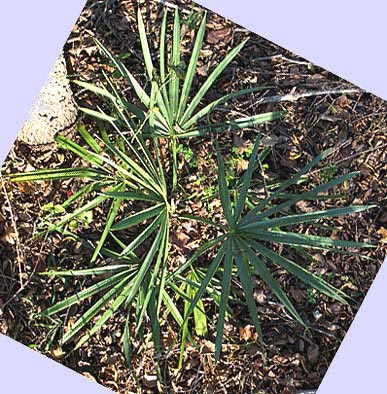
S. minor with 7 leaves visible. |
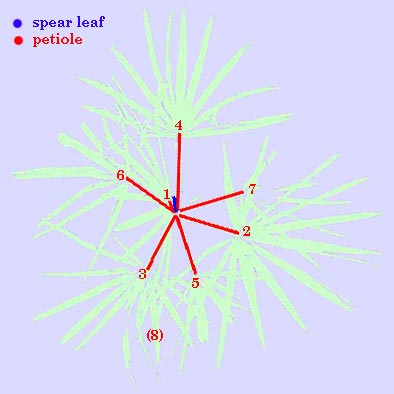
Schematization of leaves/petioles on plant to the left; 1 = youngest mature leaf; 7, oldest. |
|---|
Adult Sabal leaves are said to follow the general pattern of spiral arrangement noted by Tomlinson 1990:
Limited information suggests that phyllotaxis in palms always follows the primary Fibonacci series (0,1,1,2,3,5,8,... etc. giving spirals of 1/2, 1/3, 2/5,3/8, ... etc.). The general conclusion is that palm leaves in the crown tend to be distributed such that mutual shading is minimized, a condition which is most efficient when the ideal Fibonacci angle of divergence is achieved.... (The Structural Biology of Palms, p. 117)
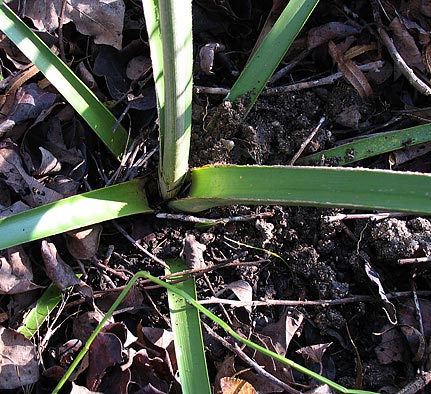
S. minor with 8 petioles visible. [Same plant as shown above.] |
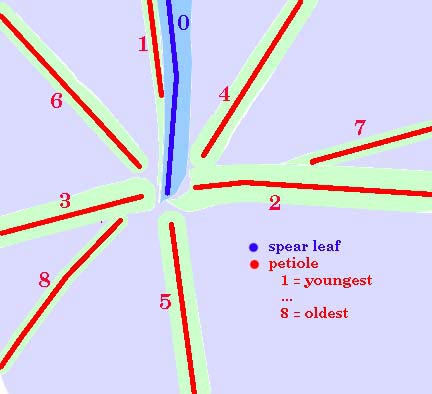
Schematization of petioles on plant to the left; 1 = youngest mature leaf; 8, oldest. |
|---|
This ideal, the 'golden angle,' has long been recognized for plant structure in general, as noted in Reinhardt et al. (2003):
A major determinant of plant architecture is the arrangement of leaves and flowers around the stem, known as phyllotaxis... Spiral phyllotaxis has received much attention from theoreticians because the divergence angle between successive leaves approaches the golden ratio of 137.58°, and the spiral arrangements are characterized by the Fibonacci numbers. (Nature 426, p. 255)
To determine how well the leaf phyllotaxis of this S. minor individual matched the golden angle ideal, the petiole angles for each successive leaf pair (color coded) in the topmost schematization above was matched against a 137.58° angle (white); presented below:
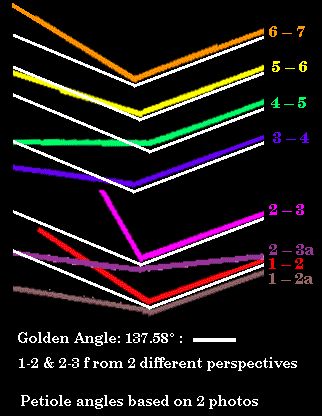
Although only pair 5—6 give a close match, a quick visual inspection of the overall differences for all pairs gives the impression (if averaged) of an approximation to the golden angle. The narrower angles of the youngest pairs, 1—2 & 2—3, did not give close matches in either photo, probably because these were the most vertically oriented leaves. Reinterpreting these two pairs from a different perspective gave much wider angles than 137.58°. An angle lying between the two perspectives appears to come very close to the ideal.
I hasten to note that botanical research in the area of phyllotaxis does not generally proceed with such superficial data. Ideally the angles need to be determined at their point of origin, with sections taken near the apical meristem (which in the case of S. minor is underground) (cf. my analysis of Rhapis excelsa leaf primordia, based on a transverse section given by Tomlinson).
With a well developed mature crown (cf. Tomlinson's analysis of the crown of Asterogyne martiana) the task is more challenging, since subsequent leaf development may be affected by environmental conditions. And with our S. minor not all leaves were the same size, with more recent leaves being larger and with broader petioles. Although the leaves are not juvenile in form, the plant has not yet bloomed. And with all leaf primordia being formed underground, they may have been subject to forces such as rocks and soil differences that could possibly account for asymmetries in petiole development.